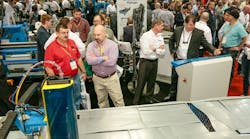Last week, I again had the opportunity to attend the International Air-Conditioning, Heating, Refrigerating Exposition (AHR Expo). It was held in Las Vegas this year—the first time since 2011—and, according to show management, broke all previous attendance records, with nearly 70,000 visitors from all over the world. Clay Stevens, the president of International Exposition Co., which manages the AHR Expo, said it also was the largest show ever in terms of square footage. If one walked the entire show, he or she would have logged more than eight miles! I believe that, as I walked nearly the entire Central Hall and a large portion of the North Hall, and my iPhone recorded 8.1 miles/22,023 steps (which also included some walking at the hotel).
Taco Comfort Solutions arguably had one of the best shows of any exhibitor. In addition to hosting a premier hospitality event, its SmartPlug Smart Hot Water Recirculation Control was named the 2017 AHR Expo Innovation Award Product of the Year. SmartPlug “learns” a home’s hot-water-use patterns to efficiently manage the availability of hot water. Taco, a long-established leader in HVAC products, had just announced its entry into plumbing products at last year’s AHR Expo in Orlando, Fla.
Another big winner was Danfoss, receiving awards in both the Building Automation and Refrigeration categories. Other finalists for Product of the Year honors were Daikin Applied (Cooling), Carrier (Green Building), Noritz America (Heating), Nortec Humidity (Indoor Air Quality), Nidec Motor Corp./U.S. MOTORS (Software), PEXOLOGY Inc. (Tools & Instruments), and Titus (Ventilation).
Riello, a world-class manufacturer of burners since building an oil burner for bread ovens in 1922, introduced to the U.S. market its modular-design high-efficiency condensing-boiler line. Using modules rated to 500 MBH and having a turndown ratio of 5:1, packages can be configured from two modules (1,000 MBH, turndown of 10:1) to eight modules (4,000 MBH, turndown of 40:1). Air-Conditioning, Heating, and Refrigeration Institute efficiency is 96.1 percent and nitrogen-oxide emissions are 9 ppm at 3-percent oxygen. Eight eight-module boiler packages (64 modules) can be cascaded to provide 320:1 modulation, with each module fully independent with its own pump.
Another product I saw that I like (in the interest of full transparency, my firm performed some analysis on this product several years ago) is Energy Guard USA’s line of corrosion-protection coatings for HVAC equipment. Energy Guard has been exhibiting at AHR for some five years and clearly is gaining traction among both users and OEMs (the coatings can be factory- or field-applied, on new or older equipment). Its Dual Cure Chemistry (DCC) technology is available in several types of coatings, all of which are low in volatile organic compounds. Because the coatings are fast-curing, there is minimal outgassing. Additionally, all DCC products resist microbial growth. Coatings are available for heat exchangers (particularly air-conditioning coils), inner equipment casings, and exterior HVAC-equipment cabinets.
Finally, I was able to spend a few minutes with Scott Arnold, executive editor of HPAC Engineering, who kindly permits me to write this blog. HPAC Engineering is part of Penton Energy and Buildings, whose booth was busy, with a host of exhibitors dropping by for video interviews. I also had the opportunity to meet some of Penton’s great staff. All-in-all, another terrific AHR Expo.









